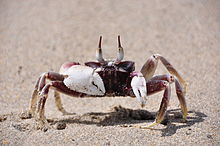- Ocypode ceratophthalmus
-
Ocypode ceratophthalmus Scientific classification Kingdom: Animalia Phylum: Arthropoda Subphylum: Crustacea Class: Malacostraca Order: Decapoda Infraorder: Brachyura Family: Ocypodidae Genus: Ocypode Species: O. ceratophthalmus Binomial name Ocypode ceratophthalmus
(Pallas, 1772) [1]Synonyms - Cancer ceratophthalmus Pallas, 1772
- Cancer caninus Herbst, 1782
- Ocypode urvillei Guérin, 1829
- Ocypoda MacLeayana Hess, 1865
Ocypode ceratophthalmus, the horned ghost crab[2] or horn-eyed ghost crab,[3] is a species of ghost crab. It lives in the Indo-Pacific region from East Africa to the Philippines and the Great Barrier Reef.[4] O. ceratophthalmus can be distinguished from other related crabs by the eyestalks extending beyond the eyes into long points,[5] which are longer in males, and shorter in females and juveniles.[3] The crabs have a box-shaped body, 6–8 centimetres (2.4–3.1 in) across the carapace, with a darker markings towards the rear in the shape of an H.[3] O. ceratophthalmus can run at speeds of up to 2.1 metres per second (6.9 ft/s).[6]
References
- ^ Sammy De Grave, N. Dean Pentcheff, Shane T. Ahyong et al. (2009). "A classification of living and fossil genera of decapod crustaceans" (PDF). Raffles Bulletin of Zoology Suppl. 21: 1–109. http://rmbr.nus.edu.sg/rbz/biblio/s21/s21rbz1-109.pdf.
- ^ "Ghost crabs". Marine Invertebrates of the National Park of American Samoa. University of Hawaii. November 10, 2009. http://www.botany.hawaii.edu/basch/uhnpscesu/htms/NPSAinvr/fish_pops/ocypod/crab01.htm. Retrieved January 2, 2010.
- ^ a b c "Horn-eyed ghost crab Ocypode ceratophthalma". Wild Singapore. May 2009. http://www.wildsingapore.com/wildfacts/crustacea/crab/ocypodoidea/ceratophthalma.htm.
- ^ "Ocypode ceratophthalma (Pallas, 1872) sic". Sealifebase. February 25, 2009. http://www.sealifebase.org/Summary/SpeciesSummary.php?id=21486. Retrieved January 2, 2010.
- ^ David Gillikin & Anouk Verheyden (November 11, 2002). "Ocypode ceratophthalmus (Pallas)". A field guide to Kenyan mangroves. http://www.madeinnys.com/mangrove/o_ceratophthalmus.htm. Retrieved January 2, 2010.
- ^ Malcolm Burrows & Graham Hoyle (1973). "The mechanism of rapid running in the ghost crab, Ocypode ceratophthalma". Journal of Experimental Biology 58 (2): 327–349. http://jeb.biologists.org/cgi/reprint/58/2/327.

This crab article is a stub. You can help Wikipedia by expanding it.

